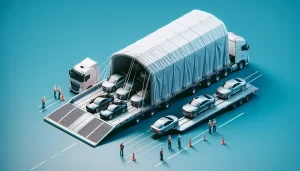Entrusting your vehicle to a shipping carrier is a significant decision. While the carrier plays a pivotal role in ensuring the vehicle’s safe transit, the responsibility doesn’t lie with them alone. Properly preparing your vehicle for shipping is paramount. This article delves deep into the preparation process, offering insights, tips, and expert advice to ensure your vehicle is primed and ready for its journey.
(Full Article on How Much It Costs to Ship a Car: LINK)
1. The Importance of Preparing Your Vehicle for Shipping: Laying the Groundwork
Ease of Inspection
- Clarity in Documentation: A clean and well-prepared vehicle allows for a more efficient inspection process, where any pre-existing damages are easily visible and can be accurately documented.
- Facilitating Accurate Assessment: The clearer the vehicle’s condition, the more straightforward the inspection, reducing the chances of disputes later on.
Safety Considerations
- Minimizing Transit Risks: Preparing Your Vehicle for Shipping, by securing loose items, ensures safety during transit, reducing the risk of damage to the vehicle.
- Compliance with Shipping Regulations: Adhering to safety guidelines, like maintaining appropriate fuel levels, aligns with shipping regulations and carrier policies.
Peace of Mind
- Confidence in Readiness: Knowing that your vehicle is well-prepared instills confidence that it’s ready for shipping, setting a positive tone for the entire process.
- Stress Reduction: Adequate preparation alleviates concerns about potential issues during transit, contributing to overall peace of mind.
2. The Cleaning Process: Enhancing Visibility and Protection
Exterior Cleaning
- Highlighting Exterior Condition: A thorough wash makes it easier to spot and document any existing external damages, ensuring they are accounted for while Preparing Your Vehicle for Shipping.
- Improving Inspection Accuracy: A clean exterior allows for a more precise and straightforward inspection, essential for accurate condition reporting.
Interior Cleaning
- Maintaining Interior Integrity: Cleaning the interior prevents any damage to upholstery and ensures that the vehicle remains in top condition throughout the transit.
- Removing Potential Hazards: Clearing the interior of loose items eliminates the risk of these items causing damage during movement.
Documenting Pre-Existing Damages
- Creating a Visual Record: Detailed photographs of existing damages serve as a crucial record, useful in case of any post-transit disputes or claims.
- Comprehensive Damage Documentation: Capturing all angles and aspects of pre-existing damages ensures a thorough and transparent record for reference.
3. Personal Items: Ensuring Compliance and Safety
Remove All Personal Belongings
- Adhering to Carrier Policies: Removing personal items aligns with most carriers’ policies and avoids potential complications during transit.
- Preventing Damage: Personal items can shift and cause damage during transport; their removal mitigates this risk.
Essential Items to Leave
- Retaining Necessary Tools: Essential items like the jack, spare tire, and vehicle tools should remain to ensure the vehicle is equipped for any situation.
- Compliance with Emergency Preparedness: Keeping these essential items in the vehicle aligns with standard emergency preparedness and functionality.
4. The Gas Tank: Balancing Safety and Functionality
A Quarter Tank Rule
- Optimal Fuel Level: Maintaining the gas tank at about a quarter full strikes a balance between reducing weight and ensuring the vehicle can be driven for necessary short distances.
- Preventing Issues: An appropriate fuel level prevents issues related to an overly full or empty tank, such as added weight or inability to move the vehicle if needed.
5. Expert Insights: Fine-Tuning the Preparation
Addressing Mechanical Issues
- Communicating Vehicle Quirks: Informing the carrier of any mechanical issues or peculiarities ensures they can handle your vehicle appropriately, preventing potential problems during transit while Preparing Your Vehicle for Shipping.
Disabling Alarms
- Avoiding Unnecessary Drains: Disabling alarms prevents battery drain and avoids potential disruptions during shipping.
Securing Loose Parts
- Preventing Damage: Securing or removing loose parts like spoilers or antennae minimizes the risk of these parts being damaged or causing damage during transit.
6. User Intent: Empowering Vehicle Owners for Shipping
Preparing with Confidence
- Informed Readiness: For those preparing to ship their vehicle, this guide provides the necessary knowledge and steps to ensure their vehicle is ready for the journey.
- Empowerment through Preparation: Understanding the preparation process empowers vehicle owners to take proactive steps, ensuring their vehicle is primed for a safe and efficient transit.
Real-world Testimonials
- Learning from Experience: Testimonials from individuals who have successfully prepared their vehicles for shipping offer practical insights and reinforce the importance of thorough preparation.
In Conclusion: Paving the Way for a Smooth Shipping Experience
Preparing a vehicle for shipping is a detailed and essential process that requires attention to various aspects, from cleaning to safety considerations. By following this comprehensive guide, vehicle owners can ensure that their vehicle is optimally prepared for transit, paving the way for a seamless and stress-free shipping experience. From the initial cleaning to the final checks, each step contributes to the overall readiness of the vehicle, providing peace of mind and setting the stage for a successful shipping journey. Remember, thorough preparation is the key to a smooth and hassle-free car shipping experience, safeguarding your vehicle and ensuring it arrives in the same condition as it departed.



